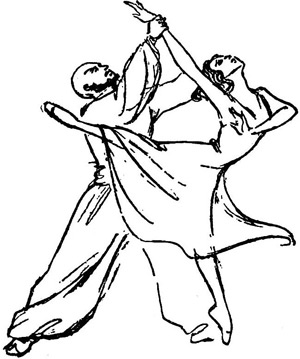|
 |
|
Maria and Girei |
The capital's ballet-lovers received a choice season's gift: the first performances of B. Asafiev's The Fountain of Bakhchisarai presented by the Experimental Ballet Troupe of the Peking School of Dancing just before the New Year holidays.
China's young ballet theatre has ably handled this notable 1934 composition which played an outstanding role in the development of Soviet classical ballet from superficial prettiness and the conventions of the fairy ballet towards full-blooded realistic dramatic expressiveness in dancing.
The libretto by N. Volkov is based on Pushkin's poem of the same name, and the music is set in the style of Russian music of the time of Pushkin. It tells of events in the latter part of the 18th century. A party is being held in a noble's house in Poland. Guests dance mazurkas and cracoviennes in the moonlight. Maria is in love with Vaslav. Invading Tartars raid the house, slaughter the guests, kill Vaslav and abduct Maria for the Khan Girei's harem in Bakhchisarai. Girei is stricken, for the first time in his life, with love for Maria. She repulses him. Zarema, Girei's former favourite, in a storm of jealousy, kills Maria. Girei orders Zarema's execution and spends the rest of his days mourning the chaste Maria beside the fountain of tears he has built to her memory.
The Chinese production at the Tianqiao Theatre has captured the mood and drama of the original tale. It was choreographed by Wang Hsi-hsien. This is the first independent production of this talented young Chinese choreographer backed up by the effective collective effort of the whole theatre. He has built on the Leningrad version first staged by the Kirov Theatre with Ulanova in the lead. Three vivid images stand out: the frustrated tyrant Girei; the gentle, lyrical Maria and the passionate Zarema. The main theme of Pushkin's poem is well brought out: force cannot conquer the spirit. The savage, despotic force personified by Girei is conquered by the pure, unyielding spirit of Maria loyal to the death to her native land and her love.
The main roles were danced by two casts in alternate performances. Chang Ling-yi and Chung Jun-liang were appealing as Maria. Liu Ching-tang and Sun Hsueh-ching were imperious Girei. Zarema was danced by the well-known ballerina Pai Shuhsiang and Chang Wan-chao. The role offers special difficulties for a young ballerina, but Pai Shu-hsiang gave a passionate and moving characterization. Among the supporting roles special laurels undoubtedly were deserved by Tsao Chi-hsin as Nurali, the fiery lieutenant of Girei, and Chou I-chi as the catty court lady who teases Zarema to distraction after her rejection by Girei. Chang Ling-yi (Maria), Sun Hsueh-ching (Girei) and Tsao Chi-hsin (Nurali) were dancing their first big roles.
There was grace and dignity but not enough sparkle in the Polish national dances of the first act - the dancers have not yet captured the full genius of these spirited dances - but the male dancers fully made up for this with the energy and verve of their Tartar warrior dances in the last act. These were splendid.
Ma Yun-hung (decor) and Li Ke-yu (costumes) did the most fruitful research for the meticulous details of their excellent original designs of decor and costumes in a romantic tradition very suited to the general style of the ballet.
The production as a whole is extremely well turned out. It shows the fast progress made by this young and promising ballet troupe which since its formation in 1959 is steadily building up a sound classical repertoire - already including Swan Lake, Giselle, Le Corsair - and also making interesting experimental efforts for the further development of the art of the ballet. | 